Westminster Abbey is a historic site with origins dating back to the 960s, featuring a Gothic architectural style. The abbey has played a central role in British history, hosting coronations, royal weddings, funerals, and significant state events. It is also home to notable figures' graves, including monarchs, poets, scientists, and politicians, as well as artifacts like the oldest door in Britain and the Coronation Chair, which has been used since 1308.
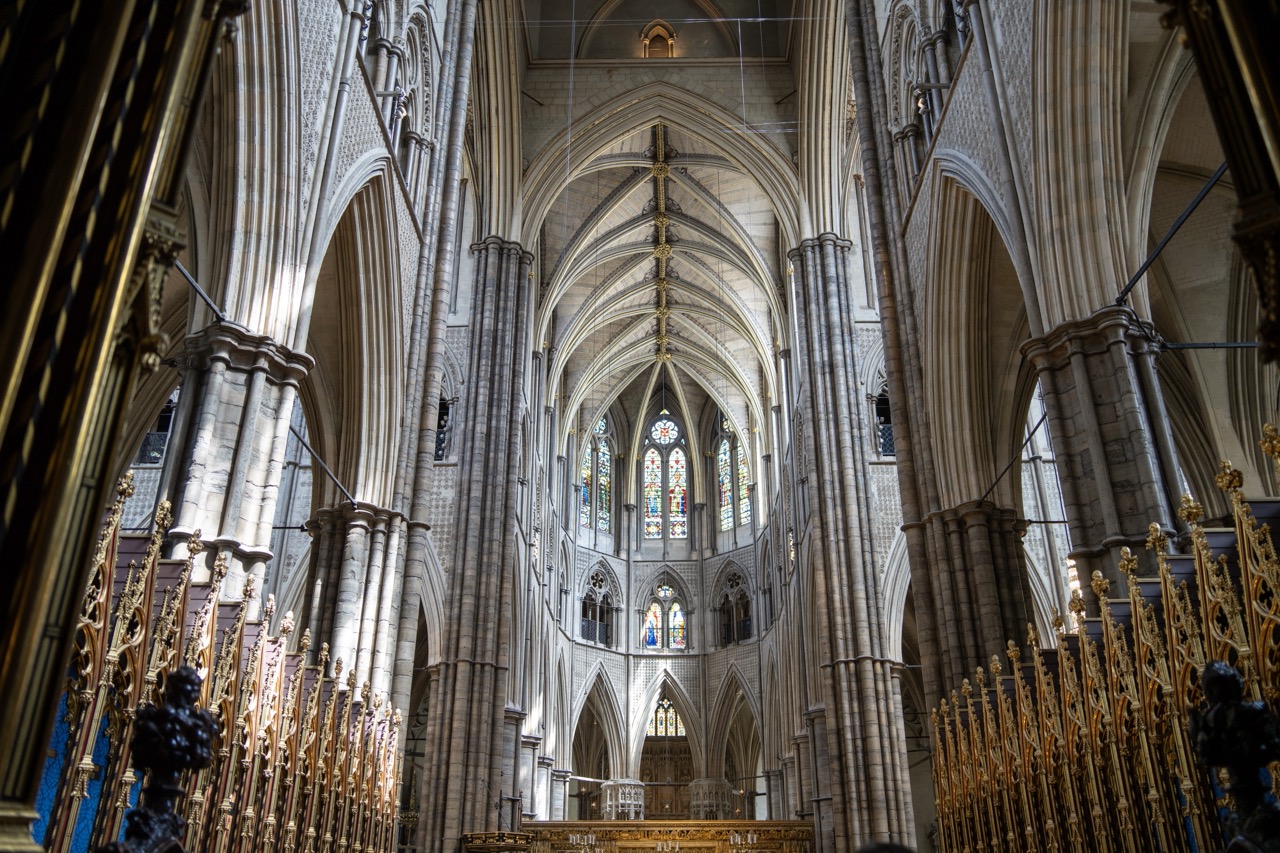

1. Overall Rating (0–10) — 8.0
This photograph captures the awe-inspiring grandeur of a Gothic cathedral interior, where soaring arches and intricate stonework converge in a symphony of verticality and light. The golden railings in the foreground add warmth and contrast, grounding the viewer in the sacred space while drawing the eye toward the luminous stained glass at the far end. While the image is technically strong and emotionally resonant, it is slightly held back by the cluttered framing of the foreground elements, which compete for attention with the architectural elegance.
2. Composition (0–10) — 7.5
The central axis of the nave creates a strong sense of symmetry and depth, guiding the eye naturally toward the apse. However, the ornate golden railings on both sides, while visually rich, slightly disrupt the balance and add visual noise, partially obscuring the cathedral’s architectural purity.
3. Lighting (0–10) — 8.5
The interplay of natural light filtering through the stained glass and the soft, ambient illumination from the side windows enhances the cathedral’s spiritual atmosphere. The light highlights the texture of the stone and casts subtle shadows that accentuate the vaulted ceiling’s complexity.
4. Color & Tone (0–10) — 8.0
The muted stone palette of the cathedral is beautifully contrasted by the warm gold of the railings and the vibrant, jewel-toned hues of the stained glass. The tonal range is well-balanced, with deep shadows and bright highlights contributing to the image’s depth and drama.
5. Creativity (0–10) — 8.0
The photograph successfully blends architectural grandeur with a sense of sacred stillness. The inclusion of the golden railings as a framing device adds a layer of narrative, suggesting both reverence and human presence, elevating the image beyond mere documentation.
6. Technical Quality (0–10) — 9.0
The image is sharp, with excellent clarity throughout the frame. Focus is precise, capturing the fine details of the stonework and the intricate metalwork of the railings. The exposure is well-managed, preserving detail in both highlights and shadows.
7. Emotional Impact (0–10) — 8.5
The photograph evokes a profound sense of reverence and awe, capturing the quiet majesty of a sacred space. The viewer is invited to feel the scale and serenity of the cathedral, making the image not just visually compelling but emotionally moving.
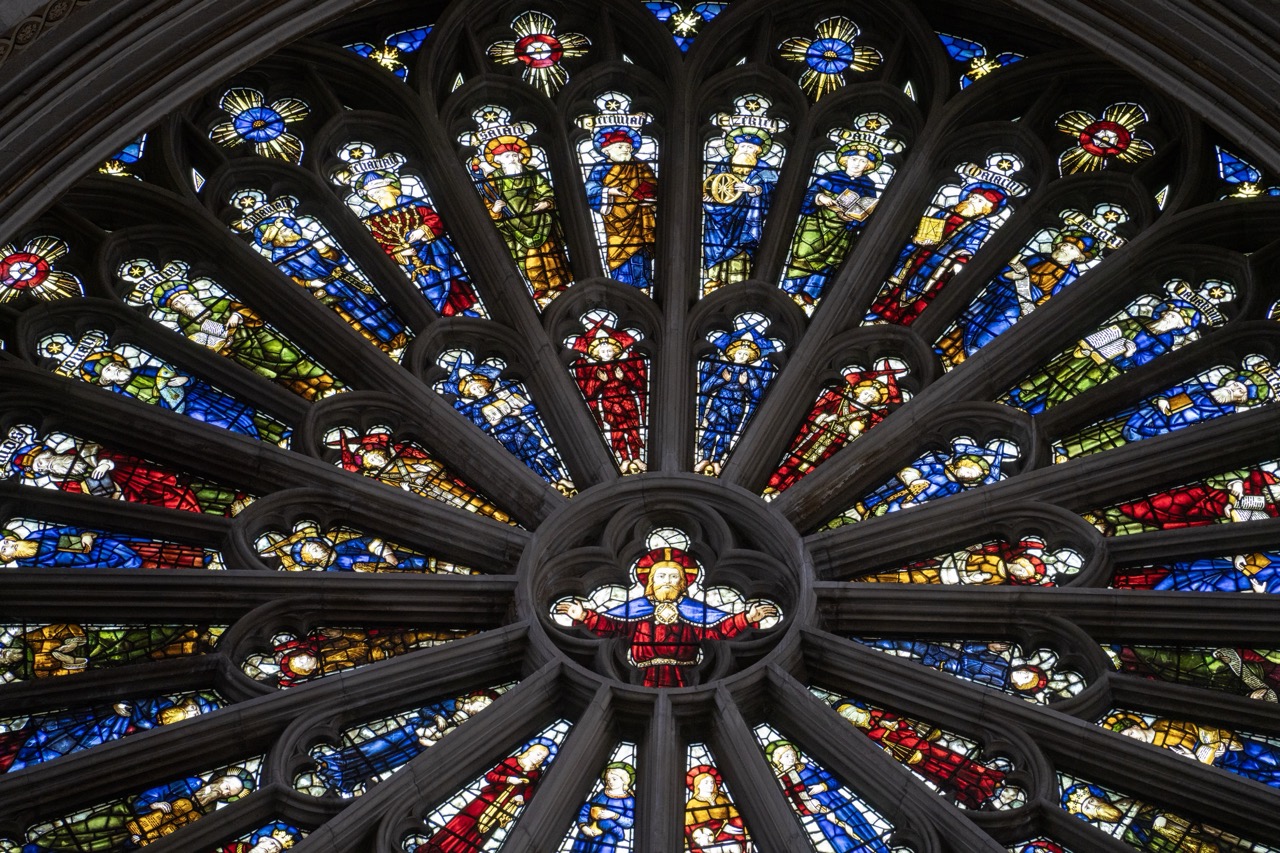

1. Overall Rating (0–10) — 8.5
This photograph captures the breathtaking symmetry and spiritual grandeur of a Gothic rose window, where light and color converge in a radiant display of religious artistry. The intricate stained glass figures, illuminated from within, radiate a sacred luminosity that draws the eye to the central Christ figure, creating a powerful sense of reverence. While the composition is visually compelling, the deep shadows between the tracery slightly obscure some of the finer details, tempering the image’s overall clarity.
2. Composition (0–10) — 9.0
The radial symmetry of the rose window is masterfully framed, with the central figure anchoring the image and the surrounding panels creating a dynamic, repeating pattern that guides the viewer’s gaze outward. The low-angle perspective enhances the sense of scale and verticality, emphasizing the architectural majesty.
3. Lighting (0–10) — 9.0
Natural light filters through the stained glass, casting vibrant, colorful illumination that enhances the spiritual atmosphere. The interplay of light and shadow within the dark stone tracery adds depth and contrast, creating a dramatic, almost ethereal glow.
4. Color & Tone (0–10) — 9.0
The rich, jewel-toned palette—dominated by deep blues, reds, and golds—evokes the traditional hues of sacred art. The contrast between the luminous glass and the dark stone enhances the vibrancy of the colors, while the warm tones around the central figure lend emotional warmth and focus.
5. Creativity (0–10) — 8.5
The image successfully captures the narrative and symbolic weight of the stained glass, transforming a static architectural element into a living story of faith. The photographer’s choice to emphasize the radial symmetry and light dynamics demonstrates a strong artistic vision.
6. Technical Quality (0–10) — 9.0
Sharp focus across the entire frame ensures clarity in both the central figure and the surrounding panels. The exposure is well-balanced, preserving detail in both the bright glass and the dark stone, with minimal noise or distortion.
7. Emotional Impact (0–10) — 9.0
The photograph evokes a profound sense of awe and reverence, inviting the viewer to contemplate the spiritual and artistic legacy of the cathedral. The luminous glow of the stained glass creates a transcendent mood, making the image not just visually striking, but deeply moving.
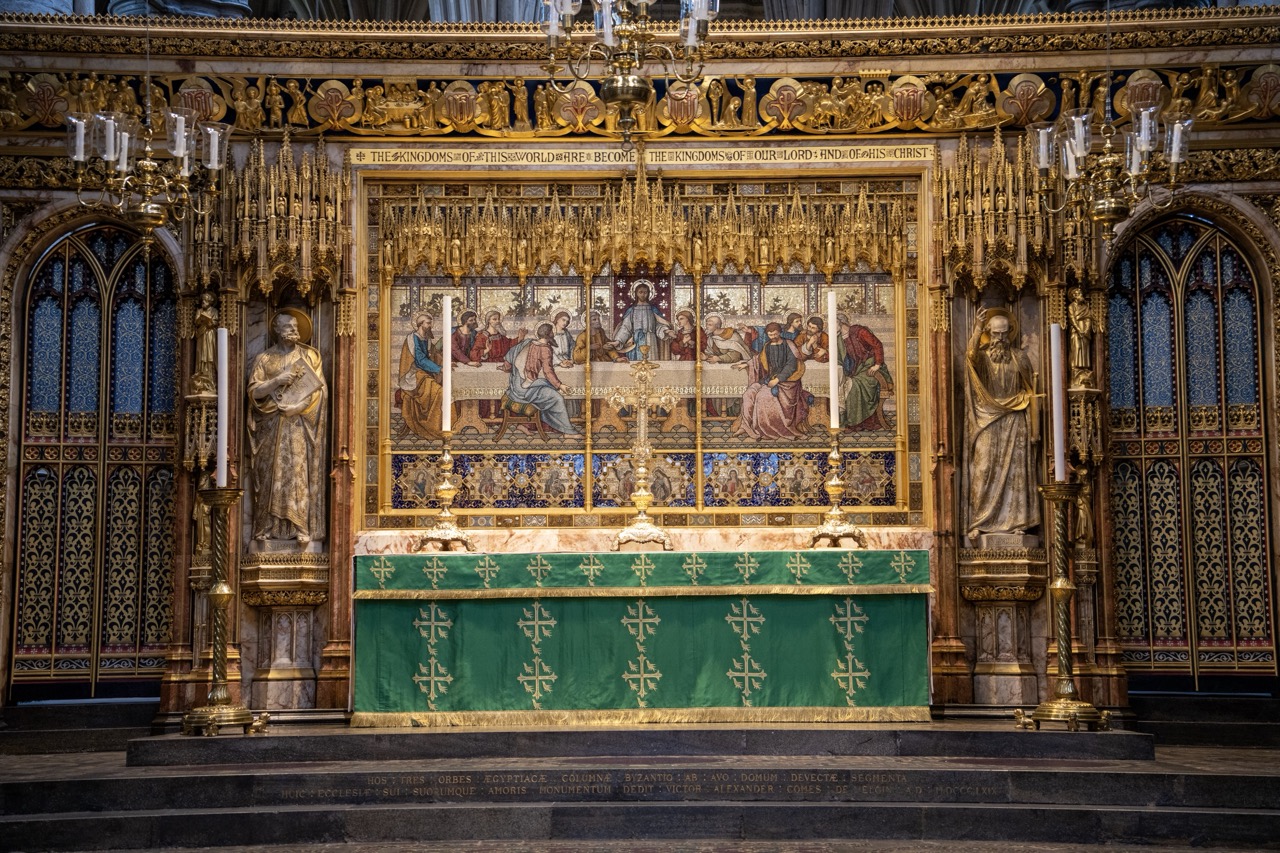

1. Overall Rating (0–10) — 8.0
This photograph captures the opulent grandeur of a Gothic cathedral altar, where sacred art and architecture converge in a symphony of gold, color, and devotion. The intricate mosaic of the Last Supper, flanked by gilded statuary and ornate tracery, radiates both spiritual reverence and artistic mastery. While the composition is rich and immersive, a slightly tighter framing could better emphasize the central narrative and reduce the visual weight of the surrounding architectural elements.
2. Composition (0–10) — 8.0
The image is centered and balanced, with the altar and mosaic as the clear focal point. The symmetrical arrangement of statues, candles, and decorative elements creates a sense of order and reverence, guiding the viewer’s eye directly to the central artwork.
3. Lighting (0–10) — 7.0
The lighting is soft and diffused, likely from natural sources within the cathedral, which enhances the depth and texture of the gold leaf and stone. The subtle shadows contribute to a contemplative mood, though the lower portion of the frame appears slightly underexposed, dimming the altar’s base.
4. Color & Tone (0–10) — 8.0
The palette is rich and harmonious, with deep green, warm gold, and the cool blue of the stained glass creating a striking contrast. The tonal range is well-balanced, emphasizing the sacred and regal atmosphere of the space.
5. Creativity (0–10) — 8.0
The photograph successfully captures the spiritual and artistic intent of the setting, presenting the altar not just as a religious object but as a work of sacred art. The choice to include the full breadth of the altar, despite its complexity, demonstrates a desire to convey the space’s full ceremonial weight.
6. Technical Quality (0–10) — 8.5
Sharp focus and fine detail are evident throughout, particularly in the mosaic and gold embellishments. The exposure is well-managed, with no harsh highlights or blown-out areas, though the lower section could benefit from slight post-processing to enhance clarity.
7. Emotional Impact (0–10) — 8.5
The image evokes a profound sense of awe and reverence, drawing the viewer into a space of quiet contemplation and spiritual significance. The interplay of light, color, and intricate design fosters a deep emotional connection to the sacred tradition it represents.
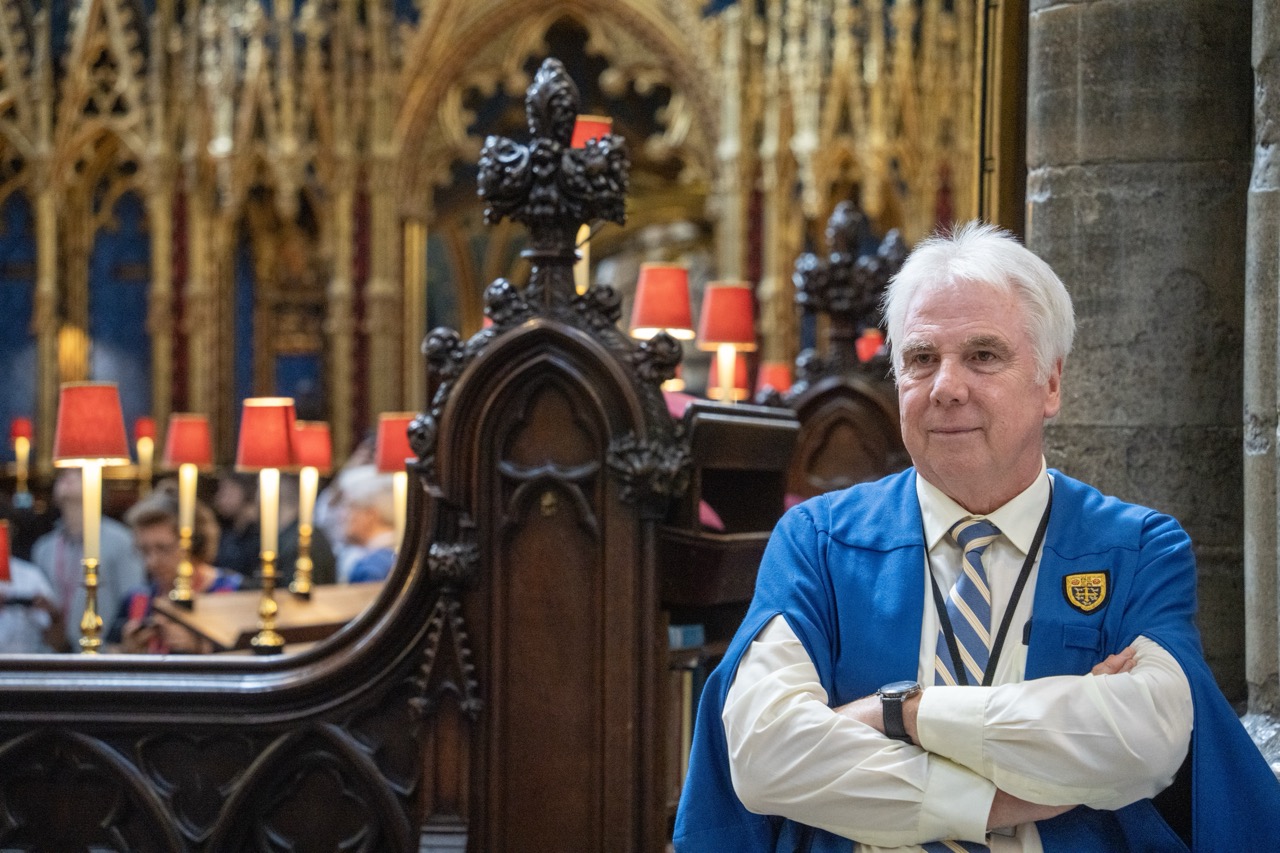

1. Overall Rating (0–10) — 7.5
This photograph captures a moment of dignified presence within a richly historic interior, where tradition and personal authority converge. The subject’s composed posture and the ornate surroundings create a compelling narrative of heritage and service, though the image’s emotional depth is slightly restrained by its formal staging. The balance between the figure and the architectural grandeur is strong, yet the background’s complexity risks distracting from the central narrative.
2. Composition (0–10) — 7.0
The subject is well-placed off-center, creating a natural visual flow toward the ornate wooden pew and the blurred background. The leading lines of the pews and the archway draw the eye into the depth of the space, though the foreground element slightly encroaches on the subject’s presence.
3. Lighting (0–10) — 7.5
Natural light from the side softly illuminates the subject’s face, complementing the warm glow of the red-shaded lamps. The interplay of light and shadow enhances the texture of the wood and stone, adding depth without creating harsh contrasts.
4. Color & Tone (0–10) — 8.0
The rich blue of the academic robe contrasts beautifully with the warm reds and golds of the lamps and architectural details, creating a visually harmonious palette. The tones are balanced and evocative, reinforcing the sense of tradition and solemnity.
5. Creativity (0–10) — 7.0
The image successfully merges portraiture with environmental storytelling, using the setting to amplify the subject’s role and status. While the concept is grounded in tradition, the composition and lighting elevate it beyond mere documentation into something more contemplative.
6. Technical Quality (0–10) — 8.5
The focus is sharp on the subject, with a shallow depth of field that elegantly blurs the background. The detail in the textures—fabric, wood, and stone—is crisp and well-rendered, indicating strong technical execution.
7. Emotional Impact (0–10) — 7.5
There is a quiet dignity and quiet confidence in the subject’s expression, which resonates with the solemnity of the space. The viewer is invited to consider the weight of tradition and the role of the individual within it, creating a subtle but meaningful emotional connection.
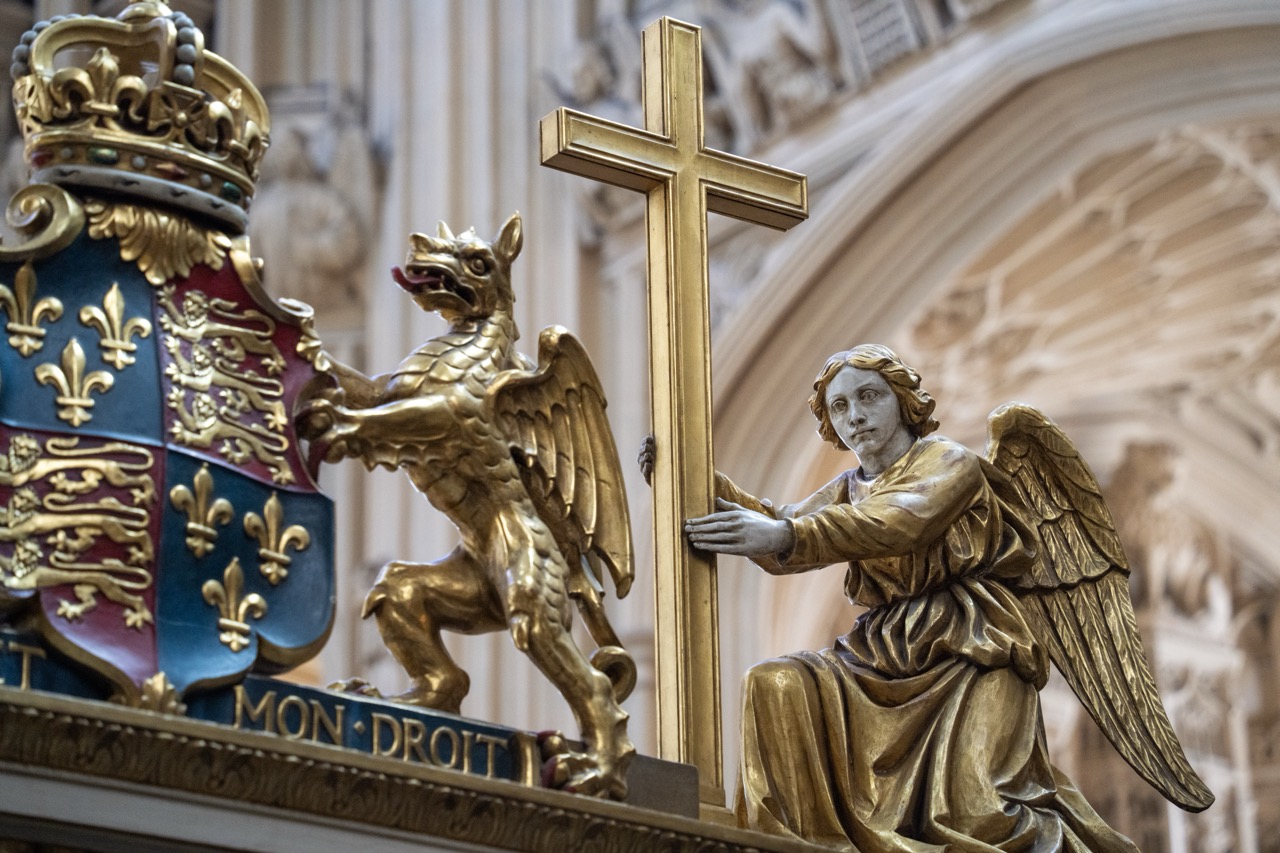

1. Overall Rating (0–10) — 8.0
This photograph captures a striking juxtaposition of religious and royal symbolism within a grand architectural setting, evoking a sense of solemn tradition and historical weight. The golden statuary gleams under soft, ambient light, drawing attention to the intricate craftsmanship of the angel, griffin, and crown-adorned shield. While the image is visually rich and thematically layered, the depth of field could be slightly tighter to further isolate the central figures from the ornate background.
2. Composition (0–10) — 7.5
The framing balances the key elements—shield, griffin, cross, and angel—across the frame, creating a sense of harmony. The diagonal placement of the cross adds dynamic tension, while the receding arches in the background provide depth. The slightly off-center angel and the dominant crest create a visual dialogue, though the composition leans slightly toward the left, giving a subtle imbalance.
3. Lighting (0–10) — 8.0
The lighting is soft and directional, likely from an overhead source, casting gentle highlights on the golden surfaces while preserving rich shadows that enhance texture and volume. The warm tone complements the gold leaf and stone, lending an ethereal glow to the scene and emphasizing the sacred and regal themes.
4. Color & Tone (0–10) — 7.5
The palette is dominated by warm golds, deep blues, and rich reds, creating a sense of opulence and gravitas. The contrast between the metallic sheen and the muted stone background enhances the visual hierarchy, though the overall tonal range is somewhat restrained, limiting dramatic impact.
5. Creativity (0–10) — 8.5
The image masterfully blends religious iconography with national heraldry, suggesting a narrative of divine right and spiritual authority. The choice to focus on this specific arrangement—where faith and monarchy converge—demonstrates strong conceptual intent and a keen eye for symbolic storytelling.
6. Technical Quality (0–10) — 8.5
The image is sharp and well-focused, particularly on the central figures, with excellent detail in the carvings and inscriptions. The shallow depth of field effectively isolates the subjects, and the exposure is balanced, capturing both highlights and shadows with precision.
7. Emotional Impact (0–10) — 8.0
The photograph evokes reverence and contemplation, inviting the viewer to reflect on the intertwined histories of faith and power. The stillness of the angel and the solemnity of the cross create a meditative mood, while the regal presence of the crown and shield lend a sense of enduring legacy.
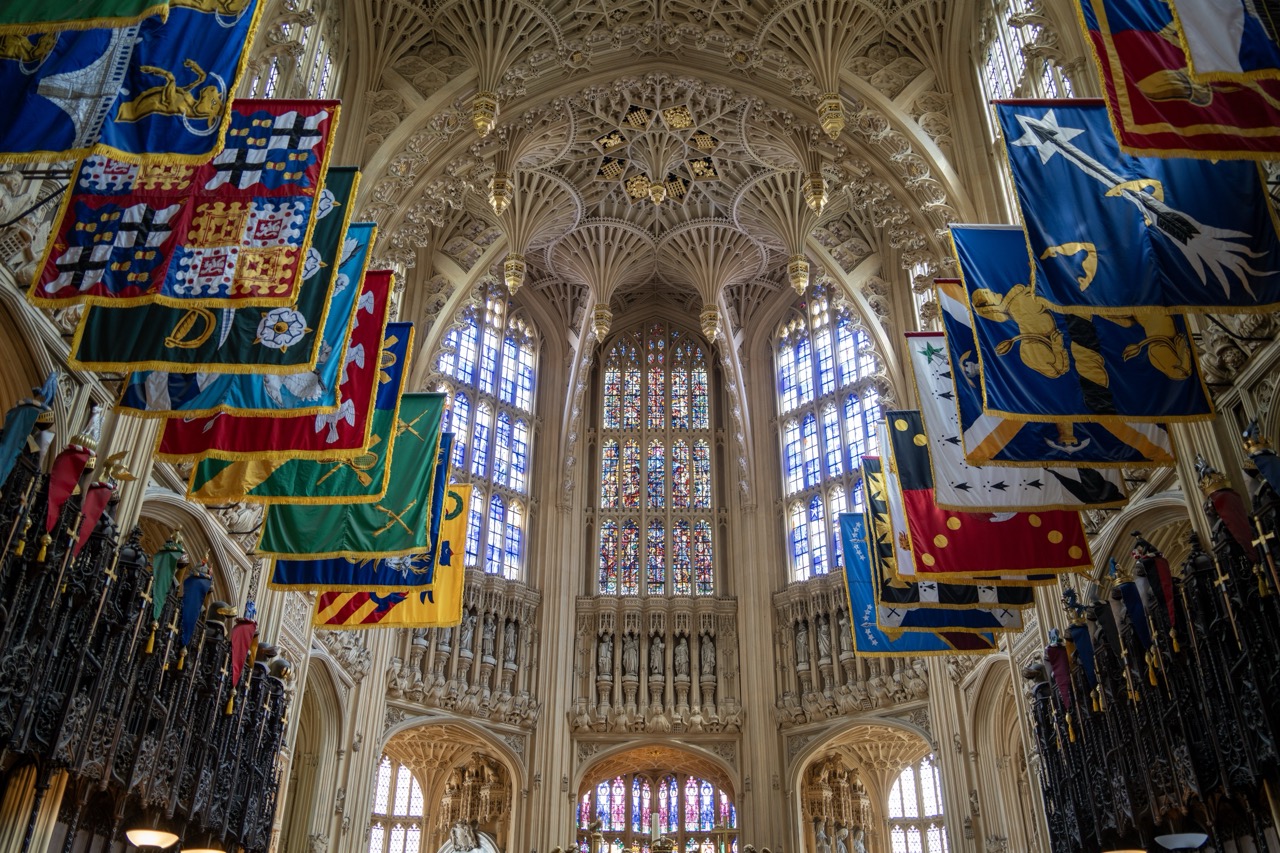

1. Overall Rating (0–10) — 8.0
This photograph captures the grandeur and spiritual weight of a Gothic cathedral interior with striking clarity and reverence. The interplay of light, intricate stonework, and the vibrant array of banners creates a powerful sense of history and ceremony. While the sheer density of flags introduces visual complexity, the composition balances it with a strong vertical rhythm, drawing the eye upward toward the vaulted ceiling. The image succeeds as both a document of architectural splendor and a moment of quiet awe.
2. Composition (0–10) — 8.5
The symmetrical framing emphasizes the cathedral’s verticality, while the banners on either side create a dynamic yet balanced rhythm. The central stained glass window acts as a natural focal point, anchoring the composition. The low-angle perspective enhances the sense of scale and grandeur.
3. Lighting (0–10) — 8.0
Natural light streams through the stained glass and tall windows, casting colorful reflections that enrich the scene. The soft, diffused illumination highlights the delicate fan vaulting and the textures of the stone, creating depth and mood without harsh shadows.
4. Color & Tone (0–10) — 8.5
The warm, golden tones of the stone contrast beautifully with the vibrant blues, reds, and golds of the banners. The stained glass introduces rich, jewel-like hues that enhance the overall color harmony. The tonal range is well-balanced, with deep shadows adding depth and richness.
5. Creativity (0–10) — 8.0
The photographer captures a moment of ceremonial tradition within a historic space, blending architecture, color, and symbolism into a cohesive narrative. The inclusion of the banners adds layers of meaning, transforming the image from mere documentation into a story of heritage and identity.
6. Technical Quality (0–10) — 9.0
The image is sharp and detailed throughout, with excellent focus and clarity. The exposure is well-managed, preserving detail in both the bright windows and the darker recesses of the nave. The use of a wide-angle lens enhances the sense of space without distorting the architecture.
7. Emotional Impact (0–10) — 8.5
The photograph evokes a profound sense of reverence, timelessness, and solemn beauty. The viewer is invited to feel the weight of history and the quiet dignity of the space, making it both visually and emotionally compelling.
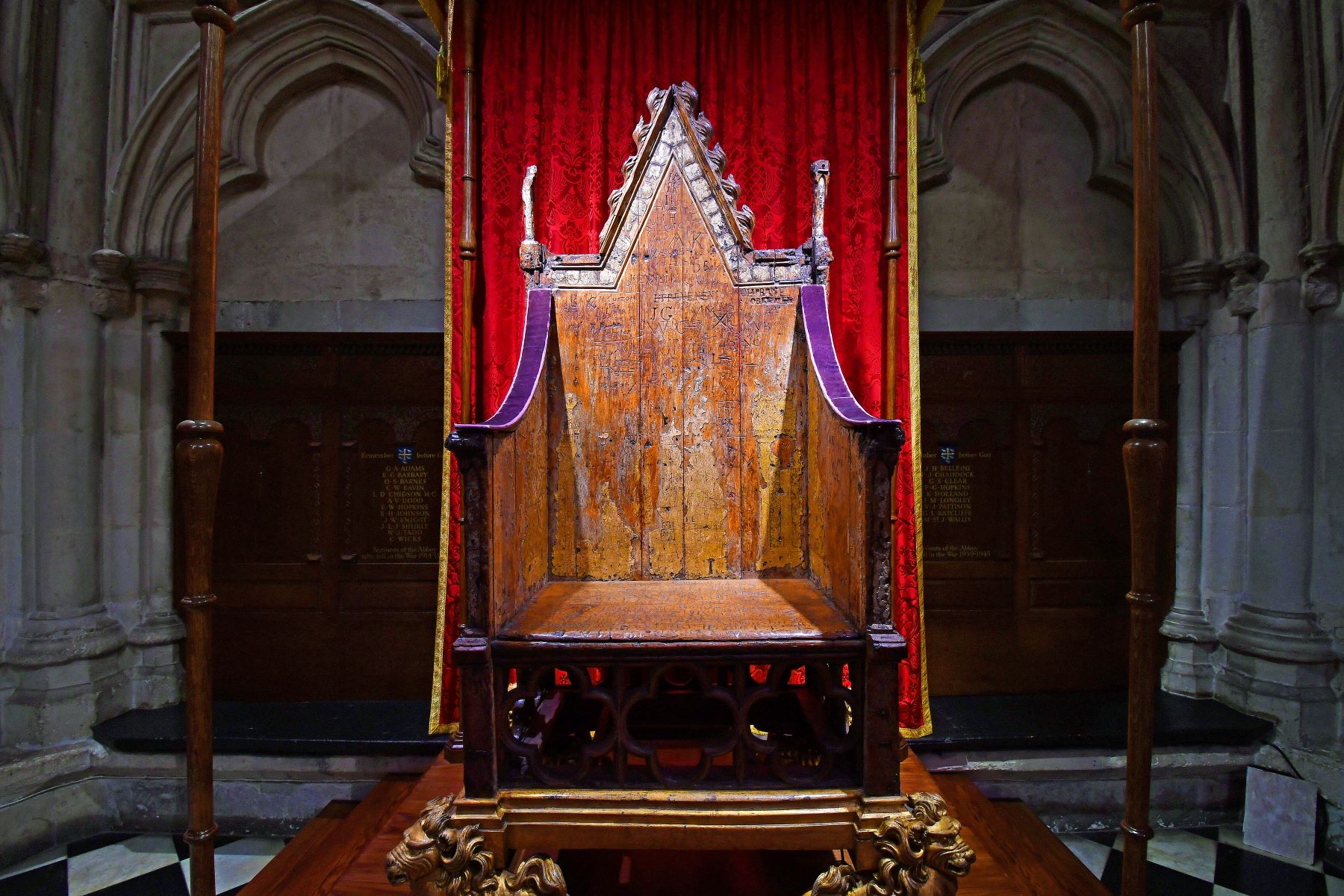

1. Overall Rating (0–10) — 8.0
This photograph captures the solemn grandeur of a historic throne within a cathedral, where age and authority converge in a single frame. The rich textures of the weathered wood, the deep red drapery, and the Gothic architecture create a powerful sense of time and place. While the image is compelling in its atmosphere, a slightly more dynamic lighting approach could enhance the sense of depth and drama.
2. Composition (0–10) — 8.5
The throne is centered and framed symmetrically by the arches and curtains, creating a strong sense of balance and focus. The vertical lines of the pillars and the throne’s back draw the eye upward, emphasizing its regal stature. The inclusion of the checkered floor adds a subtle geometric contrast without disrupting the composition.
3. Lighting (0–10) — 7.0
The lighting is soft and directional, highlighting the texture of the throne and the fabric while casting gentle shadows that add depth. The ambient light within the cathedral enhances the mood, though slightly underexposed areas in the background reduce detail and visual clarity.
4. Color & Tone (0–10) — 8.5
The deep red of the drapery contrasts beautifully with the warm, golden tones of the wood and the cool stone of the cathedral. The restrained palette enhances the image’s gravitas, with rich, saturated colors that feel both historic and dramatic.
5. Creativity (0–10) — 8.0
The image successfully blends historical documentation with artistic storytelling, using the throne as a symbol of legacy and power. The careful framing and focus on texture convey a narrative beyond mere representation, inviting contemplation of the throne’s past.
6. Technical Quality (0–10) — 8.5
The photograph is sharp and detailed, with excellent clarity in the wood grain and fabric texture. The focus is precise, and the exposure is well-managed despite the challenging low-light environment.
7. Emotional Impact (0–10) — 8.5
The image evokes a profound sense of reverence and history, capturing the weight of tradition and the quiet dignity of a sacred space. It invites the viewer to imagine the ceremonies and moments that have unfolded around this throne, creating a strong emotional resonance.
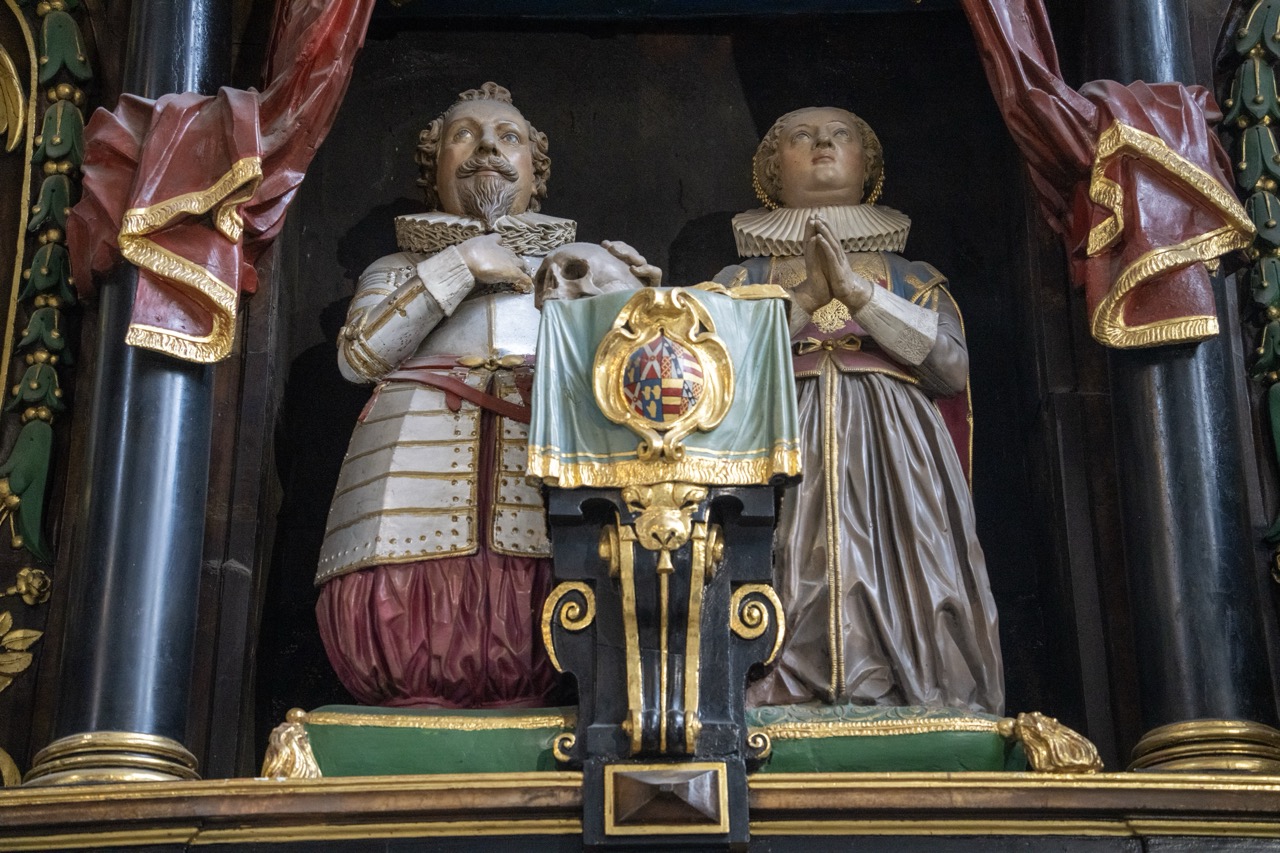

1. Overall Rating (0–10) — 7.5
This photograph captures a richly detailed religious sculpture with a striking sense of historical gravitas, where the interplay of light and shadow accentuates the intricate textures and solemn expressions of the figures. The composition draws the viewer into a moment of quiet reverence, though the slightly cluttered frame and dim lighting reduce its visual clarity. The craftsmanship of the statues and their ornate setting is palpable, but the image feels more like a documentation than a fully realized artistic statement.
2. Composition (0–10) — 7.0
The central figures are well-placed, framed by richly decorated pillars and drapery that guide the eye toward the focal point. The symmetry of the composition reinforces the solemnity of the scene, though the surrounding architectural elements slightly overwhelm the subjects.
3. Lighting (0–10) — 6.5
The lighting is soft and directional, creating subtle highlights on the gold accents and facial features while casting deep shadows that enhance the three-dimensionality of the statues. However, the overall darkness of the background and the lack of ambient light limit the image’s clarity and depth.
4. Color & Tone (0–10) — 7.5
The palette is rich and restrained, with deep reds, muted greens, and golds creating a regal, almost sacred atmosphere. The tonal contrast between the dark background and the illuminated figures adds drama, while the subdued color temperature enhances the historical and devotional mood.
5. Creativity (0–10) — 7.0
The image successfully captures the narrative and spiritual intent of the sculpture, emphasizing themes of piety and mortality. While not particularly original in approach, the photograph honors the subject with respect and visual nuance.
6. Technical Quality (0–10) — 8.0
The image is sharp and detailed, particularly in the textures of the carved wood and painted surfaces. Focus is consistent across the central figures, and the depth of field effectively isolates the sculpture from the background.
7. Emotional Impact (0–10) — 7.5
There is a quiet solemnity that resonates through the image—particularly in the upward gaze of the figures and the presence of the skull, a memento mori—evoking contemplation of faith, mortality, and legacy. The viewer is drawn into a moment of silent reverence.
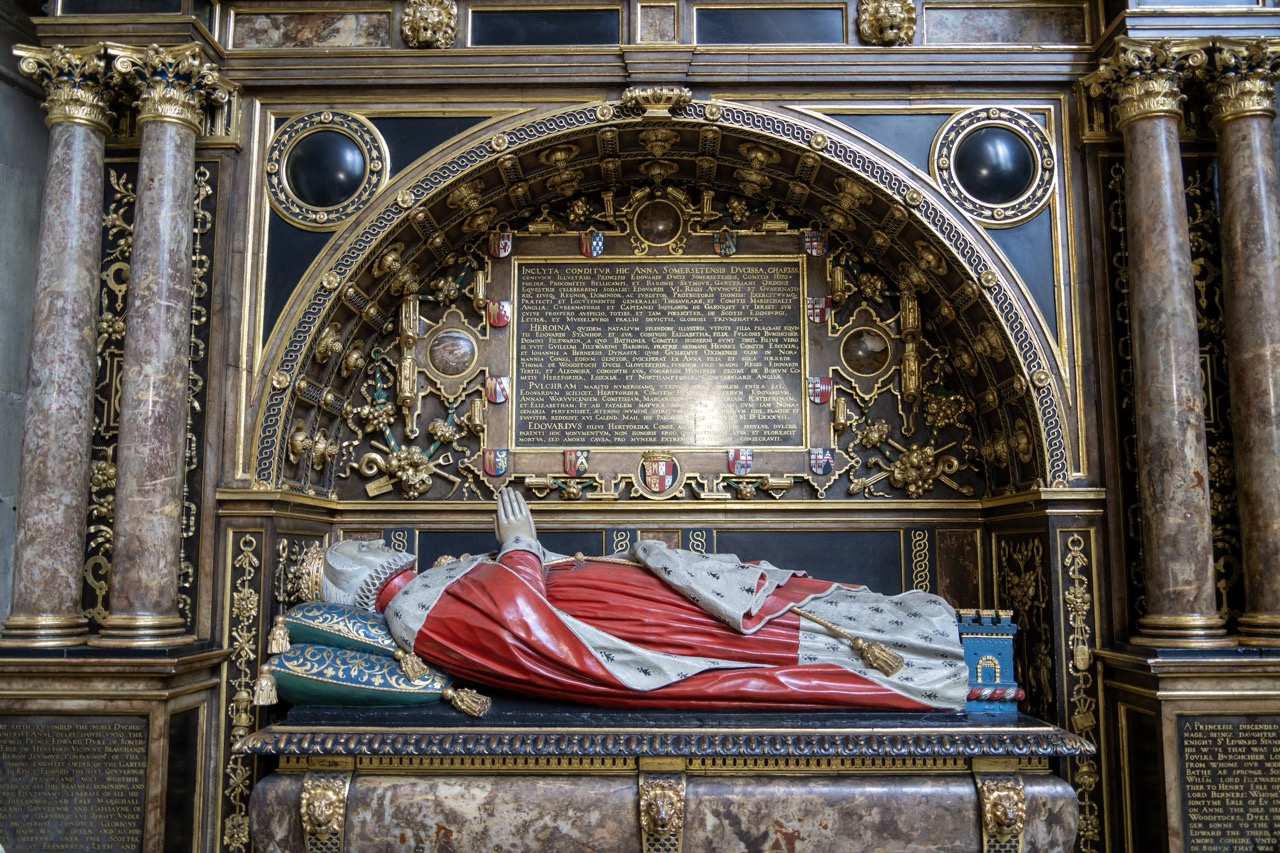

1. Overall Rating (0–10) — 8.0
This photograph captures the solemn grandeur of a historical tomb with rich detail and a sense of reverence. The intricate carvings, vibrant colors, and ceremonial posture of the effigy convey a powerful narrative of legacy and power. While the image is technically sound and visually rich, the dense ornamentation risks overwhelming the viewer, slightly diminishing the clarity of the central subject.
2. Composition (0–10) — 7.5
The symmetrical framing centers the effigy and plaque, emphasizing the monument’s formal importance. The flanking columns create a sense of enclosure, drawing the eye inward, though the lower-left text plaque slightly disrupts visual balance.
3. Lighting (0–10) — 7.0
The lighting is even and soft, highlighting the textures and gold accents without harsh glare. However, the shadows in the recessed areas of the arch slightly obscure details, reducing the overall depth.
4. Color & Tone (0–10) — 8.0
The rich reds of the effigy’s robe, the deep gold of the gilded framework, and the dark background create a striking contrast. The color palette is historically evocative, reinforcing the monument’s regal character and enhancing its visual authority.
5. Creativity (0–10) — 7.5
The image successfully captures both the artistic and historical significance of the tomb. The choice to include the full monument with its inscriptions and symbols tells a story of lineage and memory, though it leans more toward documentation than conceptual interpretation.
6. Technical Quality (0–10) — 8.5
Sharp focus and fine detail reveal the textures of the marble, fabric, and metalwork. The image is well-exposed, with balanced contrast and no noticeable noise, showcasing the craftsmanship of the monument with precision.
7. Emotional Impact (0–10) — 7.5
There is a quiet dignity in the portrayal of the effigy, evoking a sense of awe and contemplation. The viewer is invited to reflect on mortality and legacy, though the lack of human presence tempers the emotional immediacy.
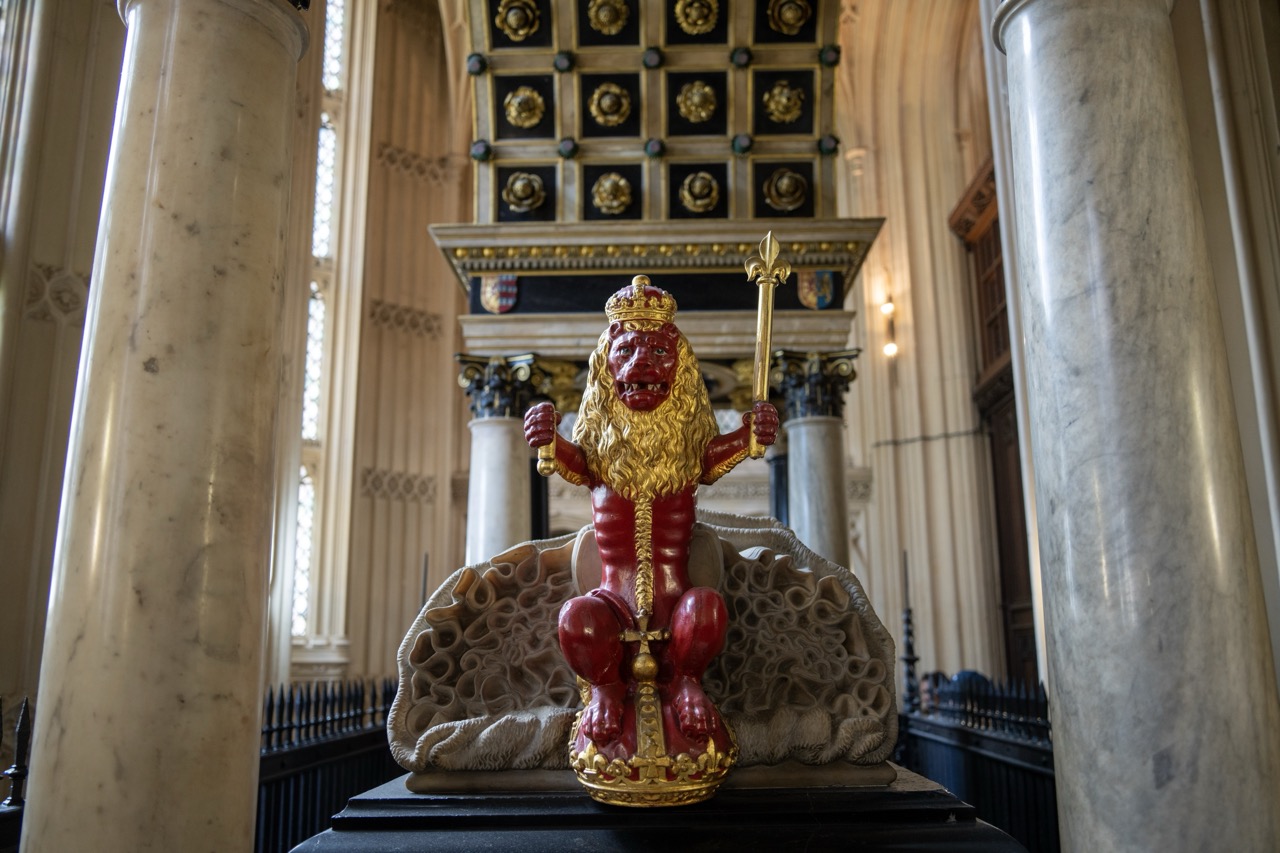

1. Overall Rating (0–10) — 8.0
This photograph captures the regal presence of a ceremonial lion statue with striking clarity and gravitas, framed by the architectural grandeur of a historic hall. The rich red and gold of the lion contrast beautifully with the cool marble and subdued tones of the surroundings, creating a sense of timeless authority. While the composition is strong, the slightly low angle and tight framing limit the full impact of the space’s scale.
2. Composition (0–10) — 8.0
The statue is centered and framed by two imposing marble columns, creating a balanced and symmetrical composition that draws the eye directly to the subject. The depth created by the receding architecture enhances the sense of scale and importance.
3. Lighting (0–10) — 7.5
Natural light filters in from the left, softly illuminating the lion’s face and crown while casting gentle shadows that emphasize texture and form. The lighting is warm and directional, enhancing the richness of the colors and lending a dignified mood.
4. Color & Tone (0–10) — 8.5
The bold red and gold of the lion stand out vividly against the neutral marble and dark background, creating a powerful visual contrast. The color palette is rich and harmonious, with warm tones dominating and a restrained use of black and gray that adds depth.
5. Creativity (0–10) — 8.0
The image successfully transforms a static architectural detail into a narrative focal point, emphasizing the symbolic power of the lion as a royal emblem. The choice to frame it through the columns adds a layer of visual storytelling, suggesting both protection and authority.
6. Technical Quality (0–10) — 9.0
The image is sharp and detailed, with excellent focus on the lion’s features and textures. The depth of field is well-managed, keeping the subject crisp while softly blurring the background to maintain emphasis.
7. Emotional Impact (0–10) — 8.5
The photograph evokes a sense of awe and reverence, capturing the solemn grandeur of a historical space. The lion’s fierce yet noble expression resonates with the viewer, suggesting strength, tradition, and the enduring weight of monarchy.
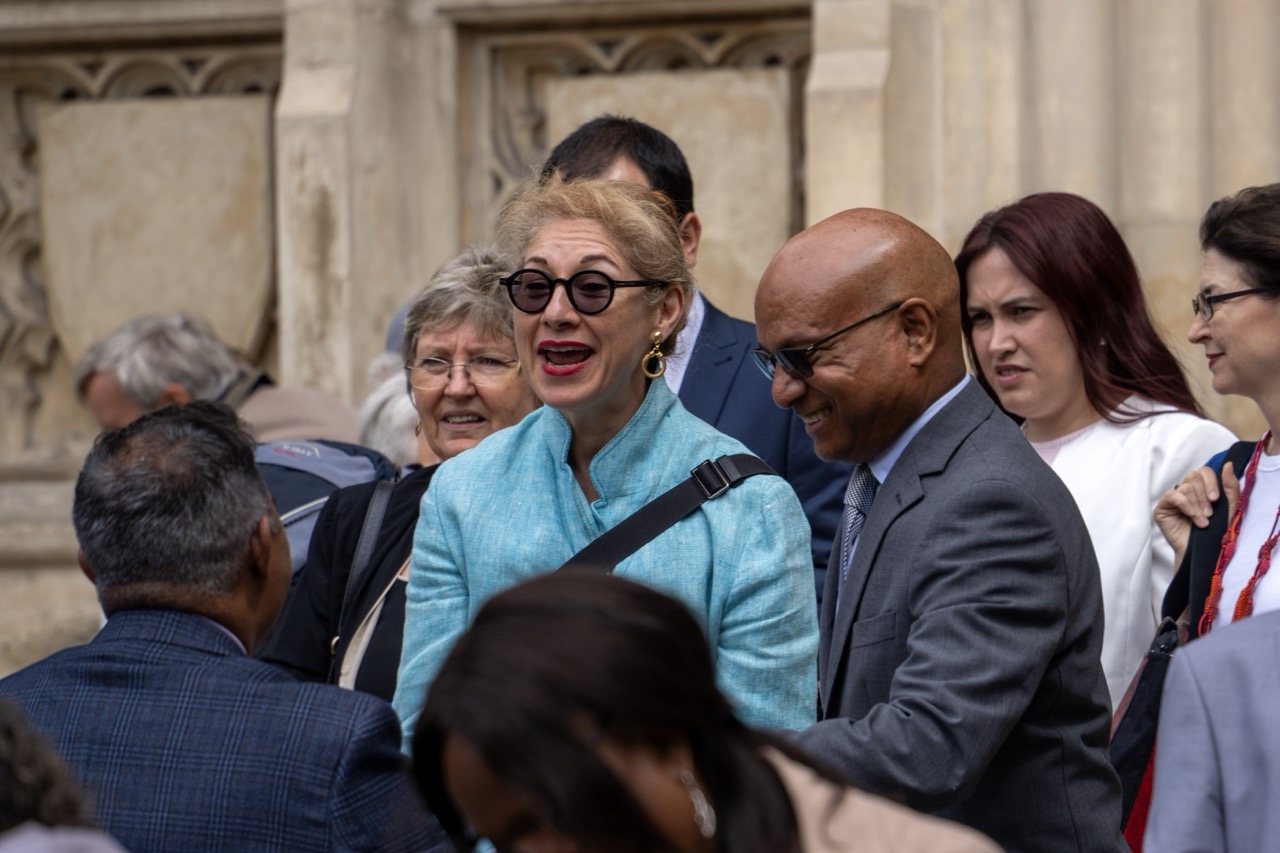

1. Overall Rating (0–10) — 7.0
This photograph captures a candid moment of joy and connection among a group of people in a public setting, with the expressive woman in the center radiating warmth and energy. The natural lighting and dynamic composition create a sense of immediacy, drawing the viewer into the scene. While the background details are slightly distracting, the emotional authenticity of the moment elevates the image beyond a simple snapshot.
2. Composition (0–10) — 6.5
The central figures are well-framed, with the woman in the light blue jacket serving as a strong focal point. However, the overlapping bodies and crowded arrangement create a sense of visual clutter, slightly weakening the overall balance and clarity.
3. Lighting (0–10) — 7.0
Natural daylight illuminates the scene evenly, preserving detail and color accuracy. The soft, diffused light enhances facial expressions and creates a sense of openness, though it lacks dramatic contrast.
4. Color & Tone (0–10) — 7.0
The palette is harmonious, with the light blue jacket standing out against the neutral tones of the suits and stone background. The warm skin tones and pops of red lipstick add visual interest and emotional warmth.
5. Creativity (0–10) — 7.5
The image succeeds in capturing a genuine, unposed interaction, offering a glimpse into a shared moment of laughter and camaraderie. The choice to focus on the emotional exchange, rather than a formal portrait, lends it a fresh, documentary-like quality.
6. Technical Quality (0–10) — 8.0
The photograph is sharp and well-focused, particularly on the central figures. The depth of field effectively isolates the subjects from the background, and the exposure is balanced with no significant technical flaws.
7. Emotional Impact (0–10) — 8.0
The genuine smiles and expressive body language convey a powerful sense of joy and human connection. The viewer is drawn into the warmth of the moment, making the image both relatable and emotionally resonant.
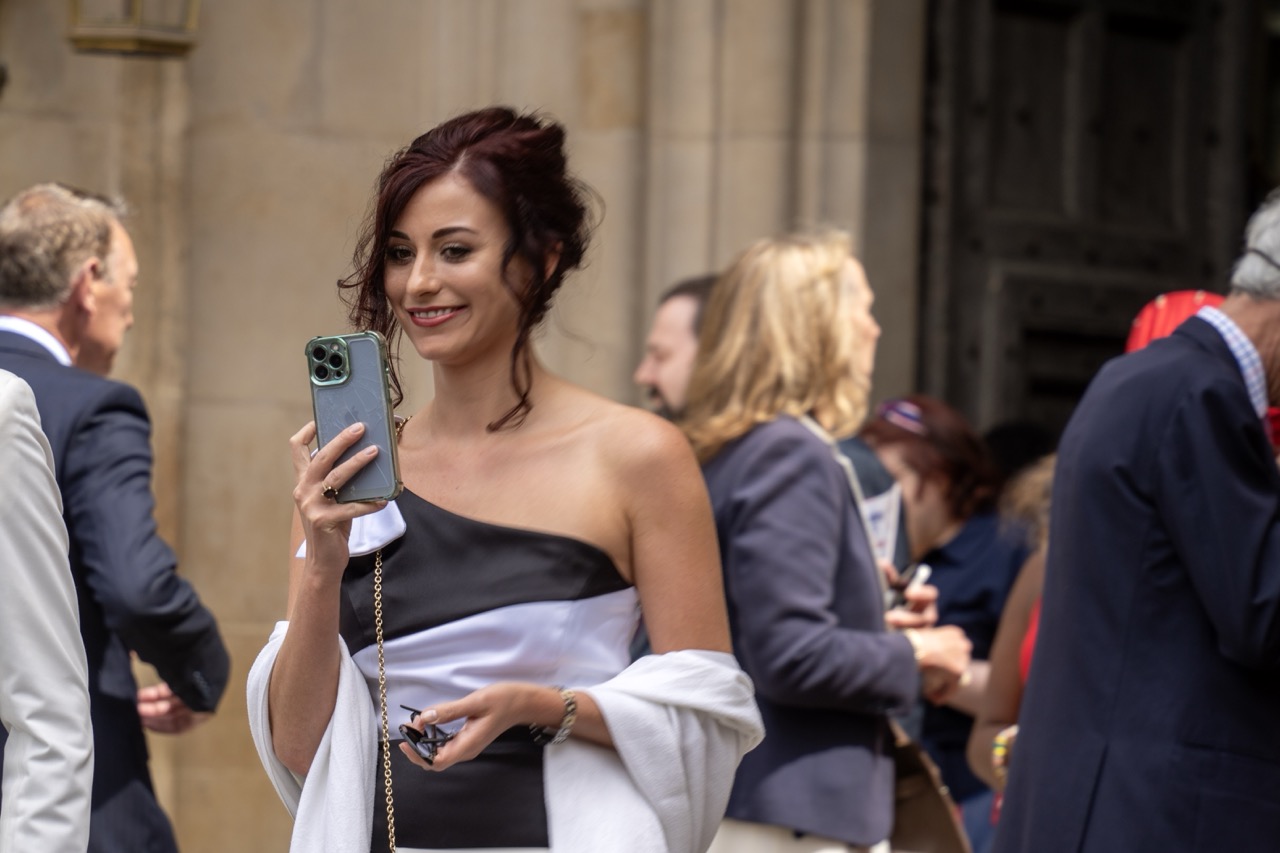

1. Overall Rating (0–10) — 7.0
This photograph captures a candid moment of elegance and modernity, where a woman in a stylish black-and-white gown engages with her phone amidst a bustling social gathering. The natural lighting and spontaneous expression lend authenticity to the scene, while her poised demeanor and the formal attire of the surrounding crowd suggest a high-profile event. Though the image is visually engaging, the background clutter slightly dilutes the focus, and the shallow depth of field, while intentional, leaves some of the surrounding context indistinct.
2. Composition (0–10) — 6.5
The subject is well-placed off-center, creating a dynamic yet balanced frame. However, the presence of multiple figures in the background, some partially cropped, introduces visual noise and distracts from the central narrative.
3. Lighting (0–10) — 7.5
Natural daylight illuminates the scene evenly, enhancing facial features and fabric textures without harsh shadows. The soft, diffused light contributes to the candid and approachable mood.
4. Color & Tone (0–10) — 7.0
The palette is composed of sophisticated neutrals—black, white, and beige—accentuated by the woman’s rich auburn hair. The colors are harmonious and understated, with a subtle contrast between the subject’s outfit and the muted background tones.
5. Creativity (0–10) — 6.5
The image succeeds in capturing a fleeting, relatable moment within a formal context, blending fashion, technology, and social interaction. While the concept is grounded in everyday reality, the execution reflects a strong sense of observational storytelling.
6. Technical Quality (0–10) — 8.0
The focus is sharp on the woman’s face and upper body, with clean detail in her attire and phone. The shallow depth of field is well-controlled, isolating the subject effectively from the background.
7. Emotional Impact (0–10) — 7.0
The woman’s warm smile and relaxed posture convey confidence and ease, inviting the viewer into a moment of quiet joy. The image evokes a sense of connection and modern elegance, resonating with themes of self-expression and social presence.
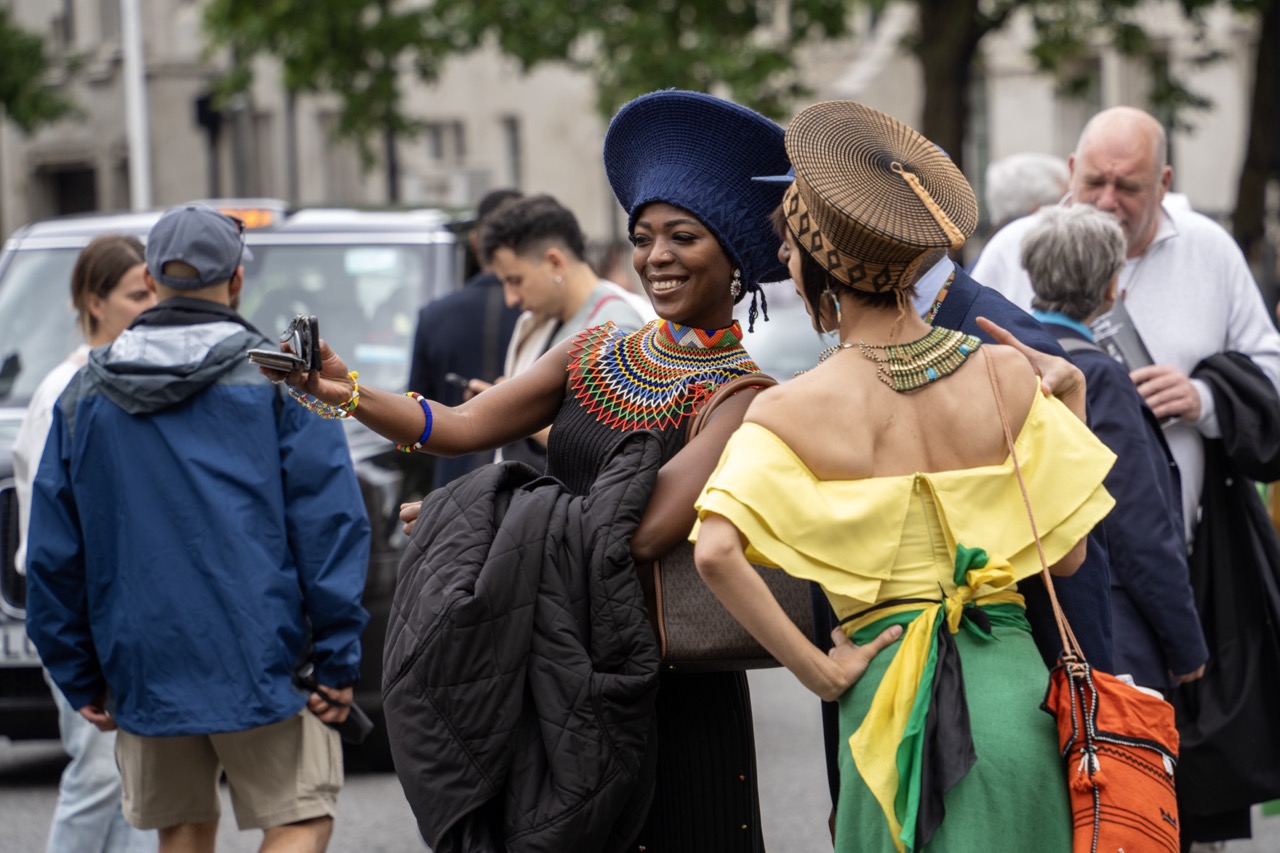

1. Overall Rating (0–10) — 7.5
This photograph captures a vibrant moment of cultural celebration and personal connection, where traditional attire meets the energy of a bustling urban environment. The joyful expressions and rich textures of the garments create a powerful sense of identity and pride, while the candid framing gives the scene authenticity. The image succeeds in balancing cultural richness with the dynamism of everyday life, though the busy background slightly dilutes the focus on the subjects.
2. Composition (0–10) — 7.0
The subjects are well-framed, with the woman in the blue hat positioned as the focal point, drawing the viewer's eye through her gesture and expression. The diagonal lines of the arms and the placement of the background figures create a sense of movement, though the cluttered surroundings slightly disrupt visual flow.
3. Lighting (0–10) — 7.5
Natural daylight illuminates the scene evenly, enhancing the vivid colors of the clothing and the warmth of the moment. The soft, diffused light avoids harsh shadows, allowing the textures and details of the garments to stand out.
4. Color & Tone (0–10) — 8.0
The palette is rich and diverse, with the bold yellows, greens, and deep blues of the traditional attire creating strong visual contrast against the muted urban backdrop. The colors feel intentional and harmonious, evoking a sense of celebration and cultural vibrancy.
5. Creativity (0–10) — 8.0
The image captures a compelling narrative—cultural pride expressed in a modern, public setting. The juxtaposition of traditional dress with contemporary city life adds depth and originality, transforming a simple moment into a story of identity and belonging.
6. Technical Quality (0–10) — 8.5
The image is sharp and well-focused, particularly on the central figures, with clean detail in the textures of the fabric and jewelry. The depth of field effectively isolates the subjects from the background, enhancing clarity.
7. Emotional Impact (0–10) — 8.5
The genuine smiles and warm interaction between the women convey a powerful sense of joy, connection, and pride. The viewer is drawn into the moment, feeling the warmth and confidence of the subjects, making the image both uplifting and memorable.
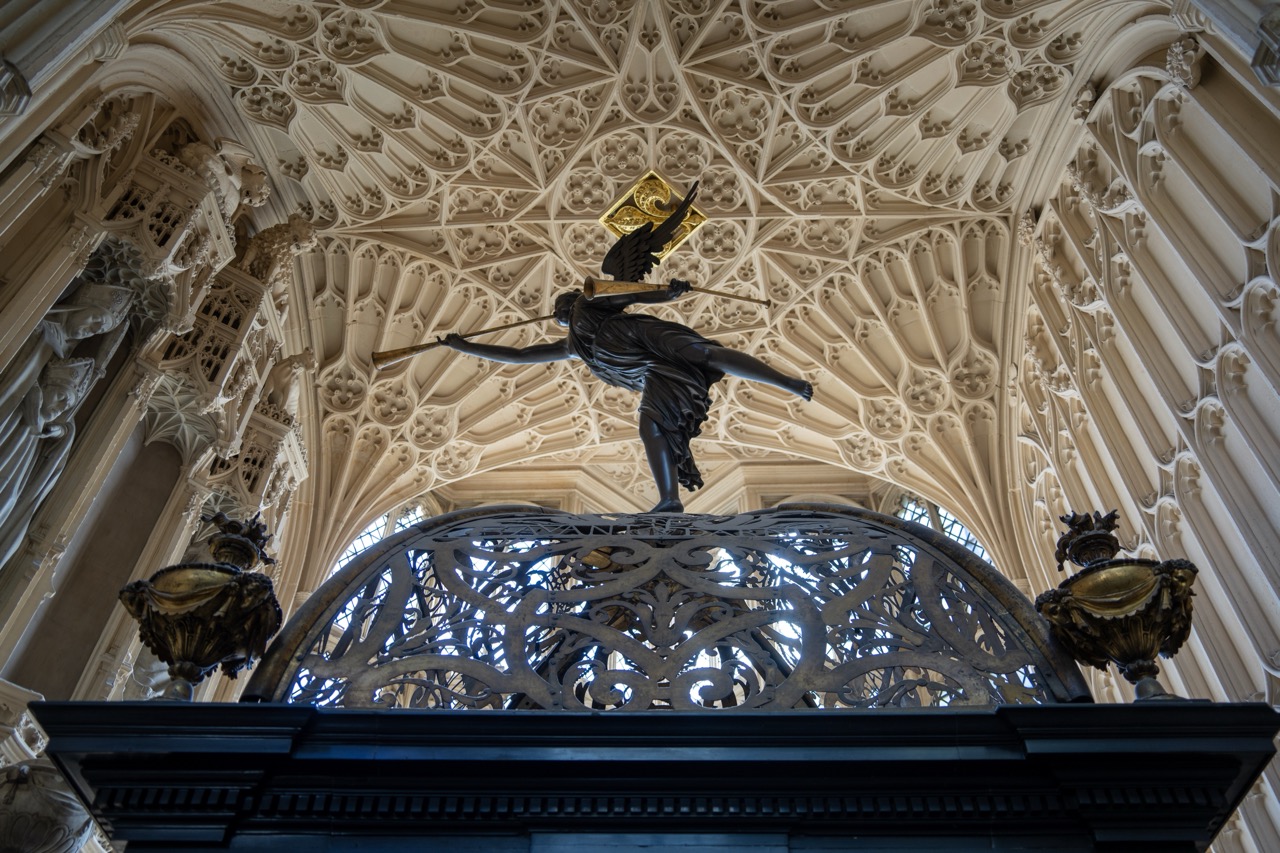

1. Overall Rating (0–10) — 8.0
This photograph captures the breathtaking grandeur of a Gothic architectural space, where the interplay of light, shadow, and ornate detail evokes a sense of divine transcendence. The dramatic low-angle perspective emphasizes the soaring vaulted ceiling and the commanding presence of the central angelic statue, creating a powerful sense of awe. While the image is rich in texture and historical weight, the dark foreground slightly obscures the lower details, tempering its visual clarity.
2. Composition (0–10) — 8.5
The low-angle shot effectively emphasizes the verticality and complexity of the vaulted ceiling, with the statue positioned as a dynamic focal point. The arched metal screen and flanking candle holders create natural framing that draws the eye toward the center, enhancing depth and balance.
3. Lighting (0–10) — 7.5
Natural light filters through the high windows, illuminating the delicate stone ribs and creating soft contrasts that highlight the ceiling’s intricate geometry. The lighting enhances the three-dimensionality of the sculpture and the architectural details, though the lower portion remains in shadow.
4. Color & Tone (0–10) — 7.0
The muted palette of cream, gold, and deep bronze conveys a sense of timelessness and reverence. The warm golden accents on the statue and candle holders provide subtle contrast, but the overall tone leans slightly cool, which slightly diminishes the warmth of the space.
5. Creativity (0–10) — 8.0
The photographer’s choice to capture the scene from below transforms a static architectural space into a dynamic visual narrative, emphasizing the monumentality of the design. The integration of the statue within the vaulted ceiling creates a compelling fusion of sculpture and architecture.
6. Technical Quality (0–10) — 8.5
The image is sharp and well-focused, with excellent detail in the stonework and metalwork. The exposure is well-managed, preserving texture in both highlights and shadows, though the darker areas lack some detail.
7. Emotional Impact (0–10) — 8.5
The photograph evokes a profound sense of reverence and wonder, inviting the viewer to contemplate the craftsmanship and spiritual intent behind the space. The combination of scale, light, and symmetry creates a deeply moving and contemplative atmosphere.
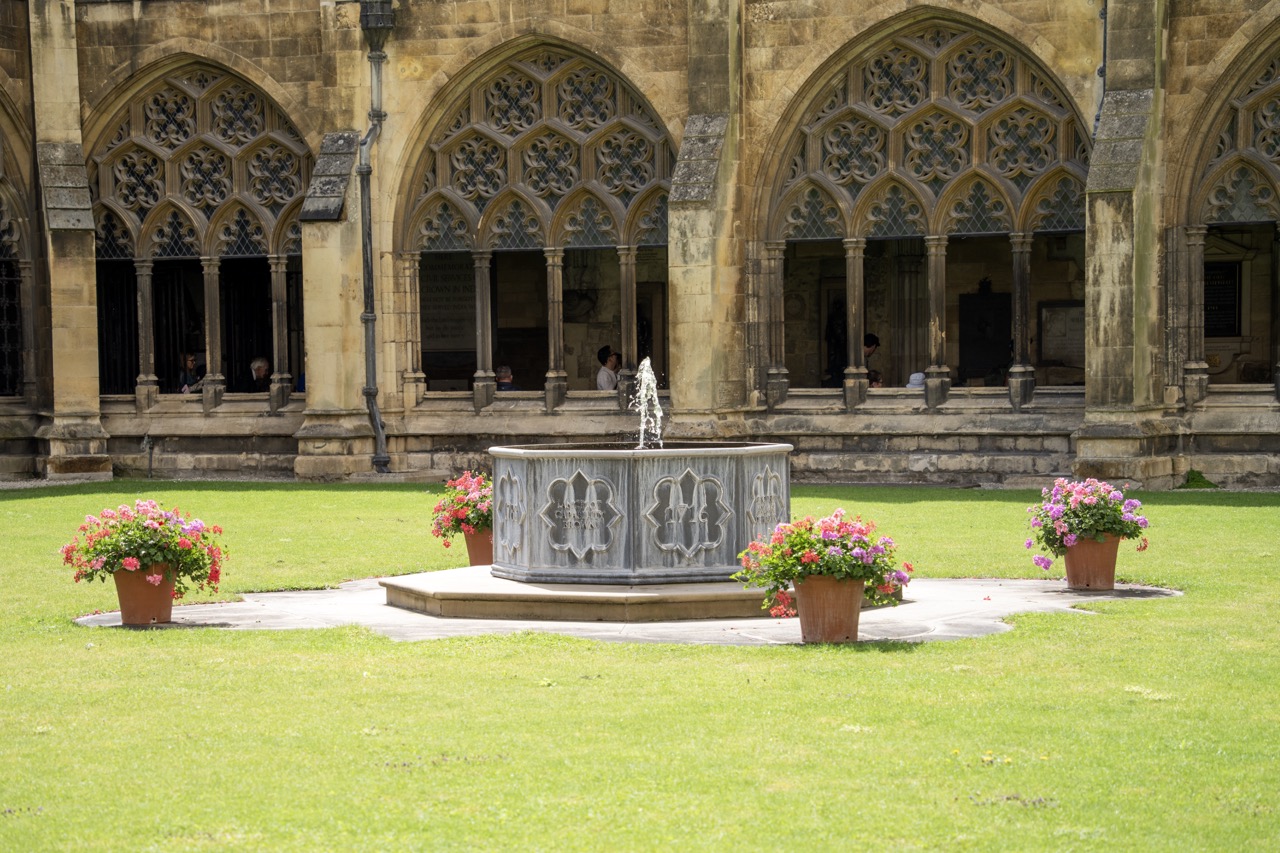

1. Overall Rating (0–10) — 7.0
This photograph captures the serene harmony of a historic cloister courtyard, where architectural grandeur meets natural tranquility. The central fountain and blooming flower pots create a balanced, inviting composition, while the Gothic arches lend a timeless, contemplative mood. Though the scene is visually pleasing, the flat lighting and slightly overexposed grass diminish the image’s depth and emotional resonance.
2. Composition (0–10) — 7.5
The symmetrical placement of the fountain and surrounding potted flowers creates a strong sense of order and visual rhythm. The repeating arches in the background provide depth and lead the eye naturally toward the central subject, enhancing the image’s architectural elegance.
3. Lighting (0–10) — 6.0
The bright, direct sunlight creates harsh highlights on the stone and overexposes the grass, reducing tonal subtlety. While the light effectively illuminates the scene, it flattens shadows and diminishes the texture of the stonework, giving the image a slightly sterile quality.
4. Color & Tone (0–10) — 7.0
The vibrant pinks and purples of the flowers provide a striking contrast against the muted greens of the lawn and the warm beige of the stone. The color palette is harmonious and evocative of a sunny summer day, though the lack of shadow detail tempers the overall richness.
5. Creativity (0–10) — 6.5
The image successfully captures the quiet beauty of a historic space, blending architectural detail with natural elements in a balanced and accessible way. While the concept is traditional and unpretentious, the careful arrangement of color and form gives it a subtle artistic appeal.
6. Technical Quality (0–10) — 7.5
The photograph is sharp and clear, with well-defined details in the stonework and foliage. Focus is consistent across the frame, and the exposure is generally accurate aside from the overexposed foreground, which slightly detracts from the image’s overall quality.
7. Emotional Impact (0–10) — 6.5
The scene evokes a sense of peace and timelessness, inviting the viewer to imagine the quiet footsteps of monks or visitors through the cloister. While the image is pleasant and reflective, the lack of dynamic lighting and emotional contrast keeps the emotional impact from reaching its full potential.
Loading map...